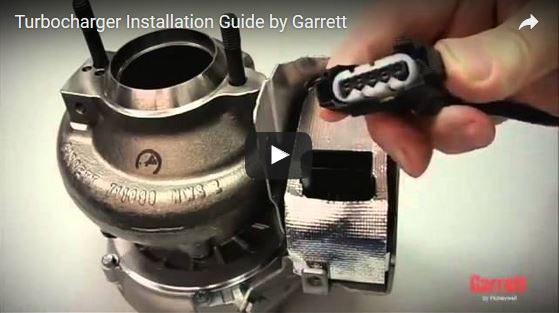
Any tips before I refit my turbocharger!
Yes, firstly I would recommend employing a qualified mechanic and I would also recommend your mechanic read this article if he is unfamiliar with fitting turbochargers...
Safety:
Prior to the removal of the turbocharger, firstly follow the manufacturers' guidelines such as removing battery terminal(s) etc. This may vary from vehicle to vehicle which can't be covered here but mechanics generally know the common safety procedures before starting any major work on a vehicle.
Precautions:
Cover any holes on the inlet and exhaust or wherever something could be accidently dropped into whilst the turbocharger is being removed, is away being repaired and during reinstallation. It' s also very important to remember to remove any covers or rags during installation, I have found many a rag in the inlet side of the turbo jammed up against the compressor wheel and on the pressure side of the turbocharger plus the odd socket, bolt or nut in the turbine housing which has consequently destroyed the turbine wheel. Anyone seen the 19mm socket?
Cleaning & Inspection:
First of all work in a clean enviroment with clean tools and hands.
I can't emphasise enough how critical it is that the oil supply pipe or hose and oil drain pipe or hose is thoroughly clean, and I mean absolutely thoroughly, 100% clean, did I mention clean? There are small oil galleries in turbochargers in which the smallest speck of any foreign matter could block. If a pipe has a lot of bends in it and your not sure if it is clean, your better off replacing it rather than risking a turbocharger failure. "When in doubt, toss it out!" In extreme cases I have found the fitting or oil supply hole from the engine to the turbocharger also blocked with carbon and/or the sump return hole blocked or partially blocked as well, also insure these are clear of any restriction or carbonisation.
Try cleaning as much excess oil as possible from the inlet pipes and exhaust if the turbo has been leaking oil. If the exhaust manifold is removed, feel in each port with your finger to see if any ports are wet which may indicate a problem with a particular cylinder and a possible cause for the turbocharger leaking or failing initially.
Check all surfaces are flat and they generally are as the materials used to make turbo components are made from high quality alloys if manufactured by a reputable company and rarely bend or crack, however some may due to a vehicle running excessive exhaust temperatures or from a design fault by the manufacturer which creates "hot-spots" from trapped exhaust gases and consequential cracking may occur. Also be wary of exhaust manifold studs, due to prolonged heat they can become brittle and break when tightening and Murphy's Law insists it is the last one you tighten when the job is near complete which will break.
Turbocharger Installation:
Now again, installation may vary from vehicle to vehicle so this is a general guide. If possible fit the oil drain pipe to the turbocharger on the bench, most use 2 bolts, gasket & plate. Make sure the surfaces are flat and DO NOT use silastic as it will restrict the inner side of the oil drain once tightened. If anything use the slightest smear of a non-hardening gasket cement just to hold the gasket in place whilst tightening the bolts. Loosely bolt the turbocharger to the exhaust manifold and again loosely on the engine and check all the intake pipes, oil pipes and engine pipe are going to align up correctly. It's best to find out something is misaligned at this point rather than tighten everything up only to find out you have to pull it all back off again.
If it is a water-cooled turbocharger, again pending the vehicle type, attach these pipes which in most cases use a threaded bolt in a banjo type fitting. I have always used liquid Teflon on the threads to help seal them, Loctite is one company which makes liquid Teflon. If everything was marked for realignment during disassembly you can tighten them all up however if they weren't marked you will have to sit the turbo on the exhaust manifold and see if there is room to tighten them on the vehicle, if not, carefully mark them and remove the turbocharger to tighten. If the water pipes are a 2 bolt plate setup you may use silastic on the water gaskets ONLY but there is still no need to overdo it.
Before fitting the oil supply pipe or hose prime the turbocharger with the aid of an oil can. I assemble our turbochargers with lubricant but some turbocharger specialists assemble them dry so it's just good practise to prime them regardless. If the oil supply pipe is a 2 bolt, plate type like the oil drain above follow the same procedure carefully, again DO NOT use silastic. If it is a flare nut type pipe and fitting again I use a small amount of liquid Teflon on the thread, push the pipe flare downwards onto its mating flare inside the oil feed of the turbocharger for proper alignment then tighten the flare nut.
Installation of Ancillary Components:
At this stage the exhaust manifold, turbo, oil supply , oil drain and water pipes (if applicable) should be all installed and tightened.
Recheck and clean the intake system, air cleaner assembly and pipes are all thoroughly clean and replace any soft or split hosing. Bolt up the engine pipe and heat shields etc. Change the oil, oil filter, air filter and fuel filter as mandatory. Use the grade of oil recommended for your vehicle and it's best to measure the amount of oil your putting into the engine as the oil level can be critical if over-filled by the smallest amount on some vehicles.
Start-Up:
If possible, prevent the engine from firing and crank the engine for 10 – 15 seconds to prime the turbocharger.
Start the vehicle and allow it to idle for a few minutes checking for any oil or water leaks allowing time for the turbocharger to be properly lubricated before slowly revving the engine. This is always a good practise for the owner to do as well when first starting his vehicle as the hot oil will drain from the turbocharger once the vehicle is turned off. Starting it and "revving the ring" out of it before the turbocharger has obtained proper oil pressure will insure an early failure.
Switch off the engine and re-check the oil and water levels.
Test drive the vehicle to insure it's running the correct boost as per the manufacturer's specifications. A dyno tune is advisable to insure the vehicle isn't running lean or rich under idle, cruise and boost conditions and check ignition timing.
Hopefully the original cause for the turbocharger failure was diagnosed and corrected, if not get ready to remove it again. Never replace a turbocharger without diagnosing why it failed in the first place.
Disclaimer:
All the above information I have learnt over many years and applies to turbocharger installations in general , however manufacture design may cause some variations to the above guide for specific vehicles. Torque settings, oil types and other specific details should be sourght from the vehicle manufacturer.

